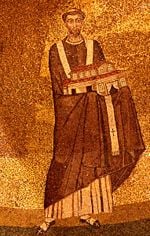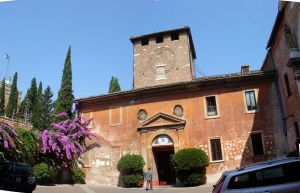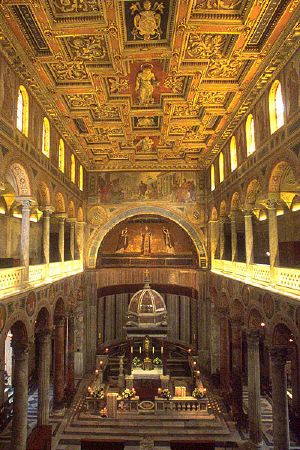Difference between revisions of "Honorius I" - New World Encyclopedia
| Line 15: | Line 15: | ||
'''Pope Honorius I''' reigned as bishop of Rome from 625 to 638. His papacy was successful in terms of missionary and administrative matters, but created controversy because of Honorius' sympathy with [[Monothelitism]], which was later condemned as heresy. After his death, Honorious himself was named as a heretic at an Ecumenical Council in 680. His condemnation later raised serious questions when the doctrine of papal infallibility became an official church teaching. He died October 12, 638. | '''Pope Honorius I''' reigned as bishop of Rome from 625 to 638. His papacy was successful in terms of missionary and administrative matters, but created controversy because of Honorius' sympathy with [[Monothelitism]], which was later condemned as heresy. After his death, Honorious himself was named as a heretic at an Ecumenical Council in 680. His condemnation later raised serious questions when the doctrine of papal infallibility became an official church teaching. He died October 12, 638. | ||
| − | + | ==Life and papacy== | |
| + | Despite his later condemnation as a heretic, Honorius was much respected during his lifetime, when [[Monothelitism]] was viewed as a compromise between the more extreme positions of [[Monophysitism]] and [[Nestorianism]]. He died with an untarnished reputation. | ||
| − | + | According to the ''[[Liber Pontificalis]]'', Honorius came from [[Campania]] and was the son of the consul Petronius. He became pope on October 27, 625, two days after the death of his predecessor, [[Boniface V]]. He reportedly modeled his papacy after that of [[Pope Gregory I]]. Honorius was particularly active in working for the Christianization of the Anglo-Saxons in England, especially [[Wessex]]. He also succeeded in bringing the Celtic [[Ireland|Irish]] [[Easter]] celebrations in line with the rest of the Roman [[liturgy]]. | |
| + | Honorius was also much engaged in the restoration and beautifying of churches of Rome, and his portrait (above) thus adorns a mosaic in the church of [[Agnes of Rome|''Sant Agnese fueri le mura'']]. The festival of the [[Elevation of the Cross]] is said to have been instituted during Honorius, pontificate. | ||
| + | [[Image:SantAgnese - cortile 00279-82st.JPG|thumb|The church of [[Agnes of Rome|Sant'Agnese]] fuori le mura, in which Honorius' portrait is located.]] | ||
| − | + | He also cared for the temporal needs of the Romans by repairing the [[aqueduct]] of [[Trajan]]. His surviving letters show him engaged in much business. He supported the Lombard King [[Adalwald]], who had been set aside as mad by an [[Arianism|Arian]] rival. He succeeded with the emperor's assistance in reuniting the schismatic metropolitan See of Aquileia (today in northeastern Italy) to the Roman Church after it had refused to accept condemnation of the [[Three-Chapter Controversy|Three Chapters]] by the Second Council of Constantinople (553) during the [[Nestorianism|Nestorian]] controversy. | |
| − | |||
| − | + | With regard to England, he sent the future Saint Birinus to convert the West Saxons. In 634 he gave appointed the future saints [[Paulinus of York]] and [[Honorius of Canterbury]] as archbishops of those cities, and he wrote a letter to King Edwin of Northumbria, which was preserved by [[Venerable Bede|Bede]]. | |
| − | [[ | ||
| − | + | In 630 he urged the Irish bishops to keep [[Easter]] with the rest of western Christendom. The Council of Magh Lene (Old Leighlin) was held as a result. There, Irish churchmen testified to their traditional devotion to the [[See of Peter]] and sent a deputation to Rome "as children to their mother." On the return of these envoys, Southern Ireland adopted the Roman use (633). | |
| − | + | ===Honorius and Monothelitism=== | |
| + | The main issue in Honorius' papacy, however, was the Monophysite controversy. The western church generally rejected this doctrine, which held that Christ's nature was essentially divine rather than essentially human. Nestorianism, on the other hand, held that Christ had two distinct natures, one human and one divine. This was rejected, particularly in the east, as too dualistic. Honorius favored [[Monothelitism]], a formula proposed by the Byzantine emperor [[Heraclius]] and Patriarch Sergius of Constantinople, which recognized Christ's two natures but admitted only “one will," which was God's will. The formula was designed to bring about a reconciliation between the [[Monophysite]]s and the [[Catholicism|Catholics]]. | ||
| − | Honorius | + | Honorius sent his deacon, Gaios, to a synod in Cyprus in 634, hosted by Archbishop [[Arkadios II]] and added also by representatives from [[Patriarch Sergius I of Constantinople]]. The anti-Monothelite side— championed in Jerusalem by [[Maximus the Confessor]] and [[Sophronius]]—disciples of these monks to the synod together with eight bishops from [[Palestine]]. When the two sides were presented to the emperor, he sided with Monothelites, and thus Honorius and his allies prevailed. |
==Anathematization== | ==Anathematization== | ||
| − | [[Image:Sant'Agnese fuori le mura | + | [[Image:Interior of Sant'Agnese fuori le mura.jpg|thumb|Interior of ''Sant'Agnese fuori le mura'']] |
| − | More than | + | The controversy between Monophystism and Nestorianism, however, continued to theaThird Council of Constantinople (680) was convened by the Byzantine emperor Constantine IV Pogonatus to settle the controversy, which still raged. Because the council decreed that Christ had two wills, Honorius' doctrine was condemned as being pro-monothelitic. Pope St. Leo II confirmed the condemnation in 682, saying that Honorius “allowed the immaculate faith to be stained” by teaching not “in accord with apostolic tradition.” Refusing to accept Honorius' doctrine, his successors condemned monothelitism, thus straining relations between Rome and Constantinople. Further, his questionable orthodoxy was revived and used by opponents of papal infallibility at the first Vatican Council (1869–70). Honorius' defenders denied that his statements were official, maintaining that his teaching was imprudent rather than heretical, and many scholars believe that it is debatable whether he was a heretic. They hold that he seems to have misunderstood the point at issue, noting that his language is partially vague. |
| + | |||
| + | More than 40 years after his death, Honorius was [[anathema]]tized by name along with the [[Monothelitism|Monothelites]] by the [[Third Council of Constantinople]] ([[First Trullan]]) in 680. The anathema read, after mentioning the chief Monothelites, "and with them Honorius, who was Prelate of Rome, as having followed them in all things." | ||
| + | |||
| + | |||
Furthermore, the Acts of the Thirteenth Session of the Council state, "And with these we define that there shall be expelled from the holy Church of God and anathematized Honorius who was some time Pope of Old Rome, because of what we found written by him to [Patriarch] Sergius, that in all respects he followed his view and confirmed his impious doctrines." The Sixteenth Session adds: "To Theodore of Pharan, the heretic, anathema! To Sergius, the heretic, anathema! To Cyrus, the heretic, anathema! To Honorius, the heretic, anathema! To Pyrrhus, the heretic, anathema!" | Furthermore, the Acts of the Thirteenth Session of the Council state, "And with these we define that there shall be expelled from the holy Church of God and anathematized Honorius who was some time Pope of Old Rome, because of what we found written by him to [Patriarch] Sergius, that in all respects he followed his view and confirmed his impious doctrines." The Sixteenth Session adds: "To Theodore of Pharan, the heretic, anathema! To Sergius, the heretic, anathema! To Cyrus, the heretic, anathema! To Honorius, the heretic, anathema! To Pyrrhus, the heretic, anathema!" | ||
Revision as of 15:50, 8 April 2008
| Honorius I | |
|---|---|

| |
| Birth name | ??? |
| Papacy began | October 27, 625 |
| Papacy ended | October 12, 638 |
| Predecessor | Boniface V |
| Successor | Severinus |
| Born | ??? Campania |
| Died | October 12 638 ??? |
| Other popes named Honorius | |
- For other persons of the same name, see Honorius.
Pope Honorius I reigned as bishop of Rome from 625 to 638. His papacy was successful in terms of missionary and administrative matters, but created controversy because of Honorius' sympathy with Monothelitism, which was later condemned as heresy. After his death, Honorious himself was named as a heretic at an Ecumenical Council in 680. His condemnation later raised serious questions when the doctrine of papal infallibility became an official church teaching. He died October 12, 638.
Life and papacy
Despite his later condemnation as a heretic, Honorius was much respected during his lifetime, when Monothelitism was viewed as a compromise between the more extreme positions of Monophysitism and Nestorianism. He died with an untarnished reputation.
According to the Liber Pontificalis, Honorius came from Campania and was the son of the consul Petronius. He became pope on October 27, 625, two days after the death of his predecessor, Boniface V. He reportedly modeled his papacy after that of Pope Gregory I. Honorius was particularly active in working for the Christianization of the Anglo-Saxons in England, especially Wessex. He also succeeded in bringing the Celtic Irish Easter celebrations in line with the rest of the Roman liturgy.
Honorius was also much engaged in the restoration and beautifying of churches of Rome, and his portrait (above) thus adorns a mosaic in the church of Sant Agnese fueri le mura. The festival of the Elevation of the Cross is said to have been instituted during Honorius, pontificate.

He also cared for the temporal needs of the Romans by repairing the aqueduct of Trajan. His surviving letters show him engaged in much business. He supported the Lombard King Adalwald, who had been set aside as mad by an Arian rival. He succeeded with the emperor's assistance in reuniting the schismatic metropolitan See of Aquileia (today in northeastern Italy) to the Roman Church after it had refused to accept condemnation of the Three Chapters by the Second Council of Constantinople (553) during the Nestorian controversy.
With regard to England, he sent the future Saint Birinus to convert the West Saxons. In 634 he gave appointed the future saints Paulinus of York and Honorius of Canterbury as archbishops of those cities, and he wrote a letter to King Edwin of Northumbria, which was preserved by Bede.
In 630 he urged the Irish bishops to keep Easter with the rest of western Christendom. The Council of Magh Lene (Old Leighlin) was held as a result. There, Irish churchmen testified to their traditional devotion to the See of Peter and sent a deputation to Rome "as children to their mother." On the return of these envoys, Southern Ireland adopted the Roman use (633).
Honorius and Monothelitism
The main issue in Honorius' papacy, however, was the Monophysite controversy. The western church generally rejected this doctrine, which held that Christ's nature was essentially divine rather than essentially human. Nestorianism, on the other hand, held that Christ had two distinct natures, one human and one divine. This was rejected, particularly in the east, as too dualistic. Honorius favored Monothelitism, a formula proposed by the Byzantine emperor Heraclius and Patriarch Sergius of Constantinople, which recognized Christ's two natures but admitted only “one will," which was God's will. The formula was designed to bring about a reconciliation between the Monophysites and the Catholics.
Honorius sent his deacon, Gaios, to a synod in Cyprus in 634, hosted by Archbishop Arkadios II and added also by representatives from Patriarch Sergius I of Constantinople. The anti-Monothelite side— championed in Jerusalem by Maximus the Confessor and Sophronius—disciples of these monks to the synod together with eight bishops from Palestine. When the two sides were presented to the emperor, he sided with Monothelites, and thus Honorius and his allies prevailed.
Anathematization
The controversy between Monophystism and Nestorianism, however, continued to theaThird Council of Constantinople (680) was convened by the Byzantine emperor Constantine IV Pogonatus to settle the controversy, which still raged. Because the council decreed that Christ had two wills, Honorius' doctrine was condemned as being pro-monothelitic. Pope St. Leo II confirmed the condemnation in 682, saying that Honorius “allowed the immaculate faith to be stained” by teaching not “in accord with apostolic tradition.” Refusing to accept Honorius' doctrine, his successors condemned monothelitism, thus straining relations between Rome and Constantinople. Further, his questionable orthodoxy was revived and used by opponents of papal infallibility at the first Vatican Council (1869–70). Honorius' defenders denied that his statements were official, maintaining that his teaching was imprudent rather than heretical, and many scholars believe that it is debatable whether he was a heretic. They hold that he seems to have misunderstood the point at issue, noting that his language is partially vague.
More than 40 years after his death, Honorius was anathematized by name along with the Monothelites by the Third Council of Constantinople (First Trullan) in 680. The anathema read, after mentioning the chief Monothelites, "and with them Honorius, who was Prelate of Rome, as having followed them in all things."
Furthermore, the Acts of the Thirteenth Session of the Council state, "And with these we define that there shall be expelled from the holy Church of God and anathematized Honorius who was some time Pope of Old Rome, because of what we found written by him to [Patriarch] Sergius, that in all respects he followed his view and confirmed his impious doctrines." The Sixteenth Session adds: "To Theodore of Pharan, the heretic, anathema! To Sergius, the heretic, anathema! To Cyrus, the heretic, anathema! To Honorius, the heretic, anathema! To Pyrrhus, the heretic, anathema!"
This condemnation was subsequently confirmed by Leo II (a fact disputed by such persons as Cesare Baronio and Bellarmine,[1] but which has since become commonly accepted) in the form, "and also Honorius, who did not attempt to sanctify this Apostolic Church with the teaching of Apostolic tradition, but by profane treachery permitted its purity to be polluted" (quotations from the Catholic Encyclopedia).
This anathema was later one of the main arguments against Papal infallibility in the discussions surrounding the First Vatican Council of 1870, where the episode was not ultimately regarded as contrary to the proposed dogma. This was because (1) Honorius was not considered to be speaking ex cathedra, by the supporters of infallibility, in the letters in question (although the Roman historian Hefele and opponents of the definition believed that Honorius had spoken ex cathedra) [2], and (2) he was alleged to have never been condemned as a Monothelite, nor, asserted the proponents of infallibility, was he condemned for teaching heresy, but rather for gross negligence and a lax leadership at a time when his letters and guidance were in a position to quash the heresy at its roots.
External links
- Guilty Only of Failure To Teach
- History of the Christian Church, Volume IV: Mediaeval Christianity. A.D. 590-1073, Philip Schaff
| Roman Catholic Popes | ||
|---|---|---|
| Preceded by: Boniface V |
Bishop of Rome 625–638 |
Succeeded by: Severinus |
| ||||||||||||||||
Original text taken from a paper copy of the 9th edition Encyclopædia Britannica (1881) and the Catholic Encyclopedia
Credits
New World Encyclopedia writers and editors rewrote and completed the Wikipedia article in accordance with New World Encyclopedia standards. This article abides by terms of the Creative Commons CC-by-sa 3.0 License (CC-by-sa), which may be used and disseminated with proper attribution. Credit is due under the terms of this license that can reference both the New World Encyclopedia contributors and the selfless volunteer contributors of the Wikimedia Foundation. To cite this article click here for a list of acceptable citing formats.The history of earlier contributions by wikipedians is accessible to researchers here:
The history of this article since it was imported to New World Encyclopedia:
Note: Some restrictions may apply to use of individual images which are separately licensed.
